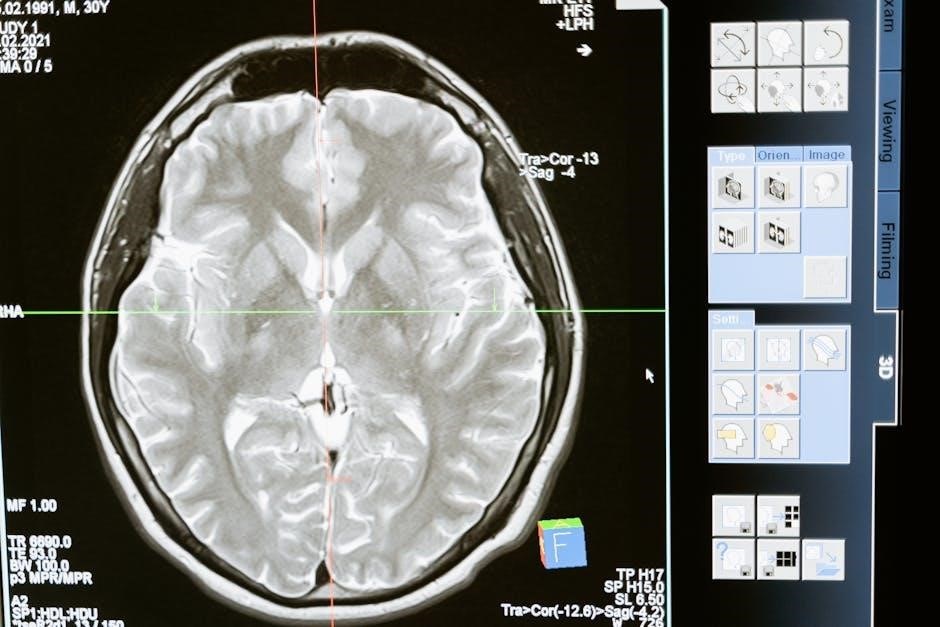The COGAT (Cognitive Abilities Test) is a K-12 assessment evaluating verbal, nonverbal, and quantitative reasoning skills. Designed for kindergarteners, it identifies gifted students through multiple-choice questions, aiding educational placement and enrichment programs effectively;
1.1. What is the COGAT Test?
The Cognitive Abilities Test (COGAT) is a widely used K-12 assessment designed to measure a student’s cognitive abilities. It evaluates verbal, nonverbal, and quantitative reasoning skills, providing insights into how a child thinks, learns, and solves problems. For kindergarteners, the test is specifically tailored to identify gifted and talented students through a series of age-appropriate, multiple-choice questions.
The COGAT test is divided into three main sections: Verbal, Nonverbal, and Quantitative. Each section assesses different cognitive abilities, such as verbal reasoning, spatial awareness, and mathematical concepts. The test is administered in a classroom setting and is completed in a relatively short period, making it accessible for young learners.

By evaluating a child’s reasoning abilities, the COGAT test helps educators and parents understand their cognitive strengths and potential. This information is often used for gifted and talented program placements and to guide personalized learning strategies. The test is a valuable tool for early identification of giftedness and for supporting academic growth in kindergarten and beyond.
1.2. Purpose of the COGAT Test for Kindergarteners
The primary purpose of the COGAT test for kindergarteners is to identify gifted and talented students at an early age. This assessment helps educators recognize children with advanced cognitive abilities, enabling them to provide appropriate challenges and support. By evaluating verbal, nonverbal, and quantitative reasoning skills, the test determines if a child might benefit from specialized educational programs.
Another key purpose is to guide educational placement. Schools use COGAT results to place students in programs tailored to their abilities, ensuring they receive stimulation and opportunities for growth. Additionally, the test aids in identifying learning gaps early, allowing for timely interventions and support.
Overall, the COGAT test serves as a foundation for future academic success, helping to create a nurturing environment where kindergarteners can thrive and develop their potential effectively.
1.3. Importance of the COGAT Test in Education
The COGAT test plays a crucial role in education by providing insights into a child’s cognitive abilities at an early stage. It helps identify gifted students who may require advanced challenges and specialized programs. Early identification enables educators to create tailored learning experiences, fostering academic growth and engagement.
The test also serves as a tool for educational planning, allowing schools to allocate resources effectively and support students with unique needs. By assessing verbal, nonverbal, and quantitative skills, the COGAT test ensures that kindergarteners are prepared for future challenges. It aids in building a strong foundation for lifelong learning and helps educators understand how students think, learn, and solve problems. Ultimately, the COGAT test is a valuable asset in nurturing young minds and preparing them for success in their educational journey.

Structure of the COGAT Test
The COGAT test is divided into three main sections: Verbal, Nonverbal, and Quantitative. Each section assesses different cognitive skills, providing a comprehensive evaluation of a child’s abilities. This structure helps educators understand strengths and areas for growth, ensuring tailored support for young learners.
2.1. Overview of Test Sections
The COGAT test for kindergarteners is structured into three primary sections: Verbal, Nonverbal, and Quantitative. Each section is designed to assess different cognitive abilities, ensuring a well-rounded evaluation of a child’s skills. The Verbal section focuses on language skills, such as vocabulary and sentence completion, while the Nonverbal section uses pictures and shapes to measure problem-solving abilities. The Quantitative section introduces basic math concepts, like counting and number recognition. Together, these sections provide a comprehensive understanding of a child’s cognitive strengths and areas for growth. The test is tailored to young learners, with age-appropriate questions and engaging formats to keep them focused; By evaluating these distinct areas, the COGAT test helps educators and parents identify how a child thinks and learns, offering valuable insights for future academic support. This balanced structure ensures that each aspect of a child’s cognitive development is thoroughly assessed.
2.2. Verbal Section
The Verbal section of the COGAT test for kindergarteners assesses language skills and vocabulary. It includes questions that evaluate a child’s ability to understand and use language effectively. Examples of question types include identifying pictures based on verbal descriptions, completing sentences, and recognizing word relationships. This section is designed to measure a child’s ability to think logically with words and understand basic language concepts. The questions are simple and engaging, often using images to help young learners stay focused. The Verbal section provides insights into a child’s communication skills and their ability to process verbal information. By identifying strengths and areas for improvement, this section helps educators and parents tailor learning strategies to support the child’s development. The Verbal section is a critical component of the COGAT test, offering a clear understanding of a kindergartener’s language abilities and potential. This section is both fun and educational for young participants.
2.3. Nonverbal Section
The Nonverbal section of the COGAT test evaluates a kindergartener’s spatial reasoning, problem-solving, and pattern recognition skills. This section uses images, shapes, and symbols to assess cognitive abilities without relying on language. Questions may involve identifying shapes, completing puzzles, or recognizing sequences. The Nonverbal section is designed to measure a child’s ability to think logically and visualize relationships between objects. It is particularly useful for assessing students who may have limited verbal skills or English language proficiency. The questions are engaging and visually appealing, making them suitable for young learners. This section helps identify children with strong visual-spatial skills, which are essential for math and problem-solving abilities. The Nonverbal section is a key part of the COGAT test, providing valuable insights into a child’s cognitive strengths and potential. It complements the Verbal and Quantitative sections, offering a comprehensive assessment of a kindergartener’s abilities. This section is both challenging and fun for young participants.
2.4. Quantitative Section
The Quantitative section of the COGAT test assesses a kindergartener’s early math skills and numerical reasoning abilities. This section focuses on basic number concepts, counting, and simple arithmetic operations. Questions may involve identifying numbers, comparing quantities, and solving basic addition or subtraction problems using visual aids. The Quantitative section is designed to evaluate a child’s understanding of mathematical relationships and their potential for further math proficiency. It uses engaging visuals and straightforward language to make the questions accessible for young learners. This section helps identify students with strong numerical aptitude, which is crucial for future academic success. The Quantitative section complements the Verbal and Nonverbal sections, providing a well-rounded assessment of a child’s cognitive abilities. It is an essential part of the COGAT test, offering insights into a kindergartener’s mathematical thinking and problem-solving skills. This section is both educational and evaluative, preparing children for more advanced math concepts in later years.

Preparing for the COGAT Test
Preparing for the COGAT test involves understanding test patterns, practicing with sample questions, and utilizing educational apps to help build familiarity and confidence in young learners.
3.1. Understanding Test Patterns
Understanding the patterns of the COGAT test is essential for effective preparation. The test is designed to assess cognitive abilities through various question types, such as shape recognition, number sequences, and picture analogies. For kindergarteners, the test focuses on basic problem-solving skills and logical reasoning. Parents and educators can access COGAT test kindergarten PDF resources, which outline the structure and format of the test. These resources often include sample questions that mimic the actual test, helping children become familiar with the question styles. By recognizing patterns, such as identifying missing shapes or understanding cause-and-effect relationships, young learners can approach the test with confidence. Additionally, these PDF guides provide insights into time management and strategies for answering questions efficiently. Understanding these patterns not only helps in preparation but also reduces anxiety, allowing children to demonstrate their true potential. Consistent exposure to these patterns ensures a smoother test-taking experience.
3.2. Sample Questions and Practice Tests
Sample questions and practice tests are invaluable tools for preparing kindergarteners for the COGAT test. These resources provide a glimpse into the types of questions and formats children will encounter, helping them become comfortable with the test structure. COGAT test kindergarten PDF materials often include age-appropriate questions that focus on shapes, colors, numbers, and basic logic. By practicing these questions, children can improve their problem-solving skills and build confidence. Practice tests also allow parents and educators to identify areas where a child may need additional support. Regular exposure to these materials helps young learners develop a routine and reduces test-day anxiety. Additionally, many PDF resources include answer keys, enabling adults to review results and provide targeted guidance. Utilizing these tools ensures that children are well-prepared and can demonstrate their abilities effectively during the actual test. Consistent practice fosters familiarity and enhances overall performance.
3.3. Tips for Parents to Help Their Child Prepare
Parents play a crucial role in helping their child prepare for the COGAT test. One effective strategy is to create a consistent study routine that incorporates fun, engaging activities. Utilize COGAT test kindergarten PDF resources to access age-appropriate practice materials. Encourage play-based learning, such as puzzles, matching games, and shape sorting, to develop problem-solving skills. Positive reinforcement is key—praise your child’s efforts to build confidence. Additionally, teach time management by simulating test-like conditions during practice sessions. Focus on fostering a growth mindset, emphasizing that challenges are opportunities to learn. Provide a supportive environment by discussing the test in a positive light to reduce anxiety. Finally, ensure your child gets ample rest and nutrition to maintain focus and energy. By combining these strategies, parents can help their child feel prepared and confident for the COGAT test.
3.4. Role of Educational Apps in Preparation
Educational apps play a significant role in preparing kindergarteners for the COGAT test by offering interactive and engaging learning experiences. These apps provide a variety of activities tailored to young learners, focusing on problem-solving, critical thinking, and creativity. Many apps include games and puzzles that align with the COGAT test format, helping children familiarize themselves with question types. Features such as progress tracking and rewards motivate kids to practice consistently. Additionally, apps often incorporate visual and auditory elements, making learning more enjoyable for kindergarteners. Parents can use apps to supplement traditional study materials, such as COGAT test kindergarten PDFs, ensuring a well-rounded preparation approach. By leveraging educational apps, children can build confidence and develop essential skills in a fun and accessible way, making test preparation a positive experience.

Scoring and Interpretation
The COGAT test uses standardized scoring based on age norms. Scores identify gifted students and guide educational planning. Interpretation helps determine a child’s cognitive strengths and areas for growth effectively for kindergarten students.
4.1. How the COGAT Test is Scored
The COGAT test is scored based on age norms, comparing a child’s performance to peers of the same age. Raw scores are converted to percentile ranks, indicating how well a child performs relative to others. For kindergarteners, the test focuses on simple shapes, colors, and basic patterns. Each section—verbal, quantitative, and nonverbal—is scored separately, with questions designed to assess reasoning and problem-solving skills. The scoring process ensures fairness by accounting for age-related developmental stages. Higher percentile ranks reflect stronger cognitive abilities. Parents and educators receive detailed reports to understand a child’s strengths and areas for growth, helping to identify gifted learners and guide educational planning effectively. This standardized approach ensures reliable and consistent results for kindergarten students.
4.2. Understanding Your Child’s Results
Understanding your child’s COGAT test results is essential for identifying their cognitive strengths and areas for growth. The test provides percentile ranks, showing how your child performs compared to peers of the same age. Scores are categorized into sections: verbal, quantitative, and nonverbal. Each section assesses different skills, such as reasoning, problem-solving, and understanding patterns. For kindergarteners, the results highlight early cognitive abilities and readiness for advanced learning. Parents receive a detailed report explaining each section’s performance, helping to identify if a child may qualify for gifted programs; It’s important to discuss the results with educators to create personalized learning strategies. While high scores are commendable, focus on using the insights to support your child’s development. Remember, these results are a snapshot of their abilities at a specific time and should guide future learning opportunities.
4.3. Using Results for Gifted and Talented Programs
The COGAT test results play a crucial role in identifying children eligible for gifted and talented programs. High scores, particularly in the 90th percentile or above, often qualify students for these programs. Schools use these results to determine if a child demonstrates advanced cognitive abilities compared to peers. The test’s sectional scores help educators understand a child’s strengths in verbal, quantitative, and nonverbal reasoning, which are key indicators of giftedness. Parents should review the score report with educators to discuss eligibility and next steps. Many schools have specific cutoff scores for program admission, so understanding these thresholds is important. By leveraging COGAT results, educators can tailor learning experiences to meet the unique needs of gifted students. This ensures they are challenged appropriately and supported in reaching their full potential. Encourage your child to view these results as a stepping stone toward exciting learning opportunities.

Benefits and Challenges
The COGAT test offers a pathway to advanced learning opportunities while presenting challenges such as test anxiety and the need for tailored preparation strategies for young children effectively.
5.1. Identifying Gifted Students Through COGAT
The COGAT test plays a pivotal role in identifying gifted students in kindergarten by assessing their cognitive abilities across verbal, nonverbal, and quantitative domains. Through its standardized format, the test helps educators pinpoint children with exceptional reasoning, problem-solving, and critical thinking skills. Early identification enables schools to provide tailored enrichment programs, fostering academic and creative growth. The test’s design ensures fairness, offering nonverbal sections to accommodate diverse linguistic and cultural backgrounds. While COGAT is highly effective, it is often used alongside other assessments to ensure a comprehensive evaluation of a child’s abilities. Parents and educators benefit from these insights, as they can support gifted learners with specialized resources and challenges. However, it’s important to address potential biases and ensure equitable opportunities for all students. Overall, COGAT serves as a valuable tool for recognizing and nurturing young minds with exceptional potential.
5.2. Building Confidence in Young Learners
The COGAT test serves as a valuable tool for building confidence in young learners by introducing them to structured assessment formats early in their educational journey. Kindergarteners gain experience in solving problems, recognizing patterns, and expressing their thoughts, which enhances their self-assurance. The test’s engaging questions, often presented through visual and interactive formats, make learning enjoyable and reduce anxiety. Parents and educators can further foster confidence by praising efforts, celebrating progress, and emphasizing the value of perseverance. By familiarizing children with test-taking skills, the COGAT test helps them develop resilience and a growth mindset, essential for future academic success. Additionally, the test highlights individual strengths, allowing learners to recognize their abilities and feel proud of their achievements. This positive reinforcement creates a strong foundation for lifelong learning and personal development.
5.3. Common Challenges Faced by Kindergarteners

Kindergarteners often face unique challenges when taking the COGAT test, primarily due to their developmental stage; One common issue is time management, as young children may struggle to complete tasks within the allotted time. The test format, which includes verbal, nonverbal, and quantitative sections, can be overwhelming for some. Vocabulary limitations and unfamiliar question types may lead to confusion. Additionally, fine motor skills required for drawing or writing answers can be a hurdle for those still mastering handwriting. Shyness or hesitation in expressing ideas aloud may also impact performance. Furthermore, the length of the test can cause fatigue, especially for young learners with shorter attention spans. Lastly, some children may feel anxious due to the structured nature of the test, which differs from their typical play-based learning environment. These challenges highlight the need for preparation and support to ensure a positive experience.

Resources and Support
Official COGAT test guides, educational apps, and online platforms offer practice materials and study aids. Teachers and parents provide additional support to help young learners prepare effectively for the assessment.
6.1. Free PDF Resources for COGAT Preparation

Free PDF resources for COGAT preparation are widely available online, offering a cost-effective way to help kindergarteners practice and familiarize themselves with the test format. These resources often include sample questions, exercises, and study guides tailored to the cognitive abilities of young children. Many official COGAT test preparation websites provide downloadable PDFs that cover verbal, nonverbal, and quantitative sections. Additionally, educational forums and parenting websites share PDF guides specifically designed for kindergarten-level COGAT tests. These materials are helpful for parents and educators aiming to understand the test structure and improve a child’s problem-solving skills. Some PDFs also include tips for administering practice tests at home, ensuring a stress-free learning environment. By utilizing these resources, families can provide their children with a solid foundation for success on the COGAT test.
6.2. Online Tools and Platforms for Practice
Online tools and platforms offer interactive and engaging ways for kindergarteners to practice for the COGAT test. Websites like TestPrep-Online and Brillant provide comprehensive practice materials, including games, puzzles, and interactive exercises tailored to young children. These platforms often feature timed sessions to help build time management skills and familiarize kids with test conditions. Additionally, many online tools include progress tracking, allowing parents and educators to monitor improvement areas. Some platforms also offer video tutorials and audio instructions to cater to the learning styles of kindergarteners. These resources are accessible from any device, making practice convenient and flexible. By leveraging these tools, children can enhance their problem-solving abilities and build confidence in a fun and supportive digital environment.
6.3. Guidance for Teachers and Parents
Guidance for teachers and parents is essential to support young learners preparing for the COGAT test. Educators can create a nurturing environment by introducing test concepts gradually, using age-appropriate language, and emphasizing problem-solving skills. Parents should encourage regular practice, fostering a positive attitude toward learning. Both should focus on building confidence rather than pressuring the child. Teachers can incorporate COGAT-like activities into daily routines, such as puzzles, pattern recognition, and sequencing games. Parents can use storytelling and everyday situations to enhance verbal and quantitative reasoning. Collaboration between teachers and parents ensures consistent support, helping kindergartners feel prepared and confident. Providing clear explanations of test formats and practicing time management can also ease anxiety. By working together, teachers and parents can help children approach the COGAT test with curiosity and readiness, laying a strong foundation for future academic success.
The COGAT test plays a significant role in identifying gifted students and guiding educational strategies. By supporting young learners and fostering their development, we pave the way for future academic excellence.
7.1. Final Thoughts on the COGAT Test
The COGAT test serves as a valuable diagnostic tool for understanding kindergarten students’ cognitive abilities and readiness for advanced learning. It provides educators and parents with insights into a child’s strengths and areas for growth, enabling tailored educational strategies. While the test is not a definitive measure of a child’s potential, it offers a comprehensive view of their problem-solving, verbal, and quantitative skills. Parents should approach the test as an opportunity to identify their child’s unique learning needs rather than a source of stress. By fostering a positive mindset and using the test results constructively, families can support their child’s educational journey effectively. The COGAT test, when used appropriately, can be a stepping stone for nurturing giftedness and fostering a lifelong love for learning in young students.

7.2. Encouraging Lifelong Learning Through Assessment
The COGAT test for kindergarten serves as a foundational tool to inspire a love for learning in young children. By assessing their cognitive abilities, the test helps identify areas where they may excel or need additional support. This early insight allows parents and educators to create personalized learning experiences that foster curiosity and creativity. The test’s focus on problem-solving and critical thinking encourages children to develop skills that are essential for lifelong learning. Moreover, the COGAT test’s structured format introduces children to the concept of assessment in a positive and engaging way, helping them view challenges as opportunities for growth. By leveraging the results of the COGAT test, families can provide enrichment activities that align with their child’s interests and strengths, setting the stage for a future filled with academic exploration and personal development.

